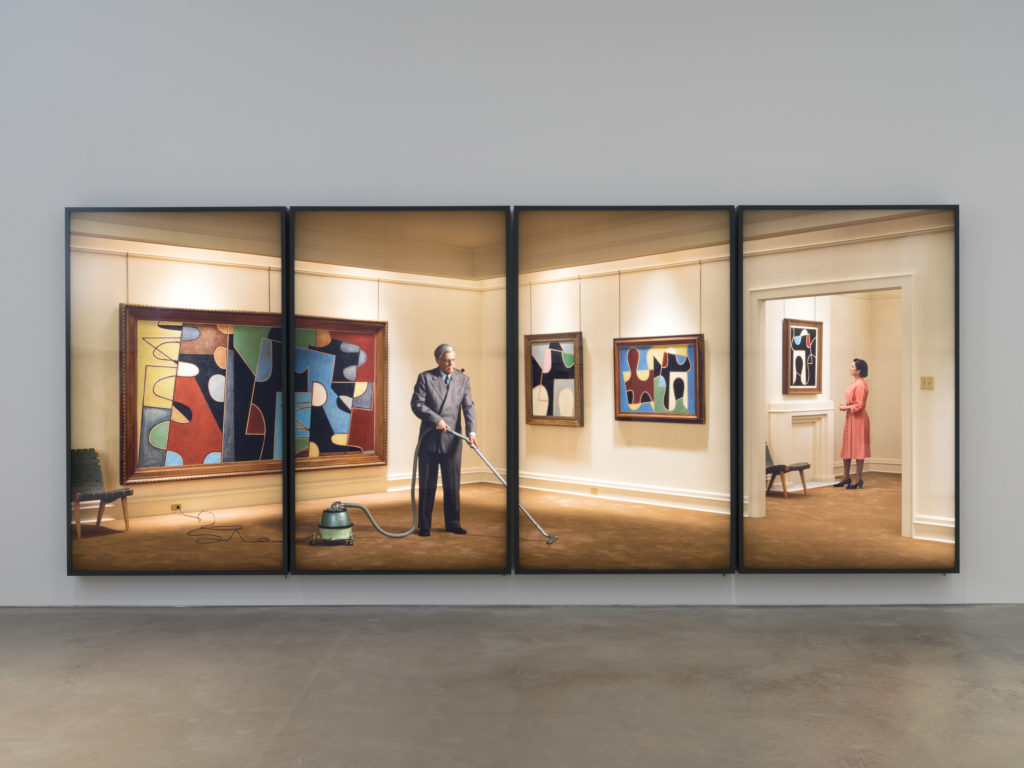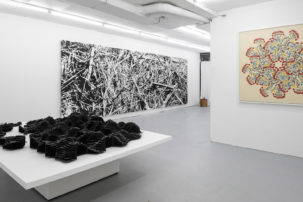Since 2007, Rodney Graham has assumed many roles in his photographs: dozing collector, urban fisherman, bemused biologist, try-hard film professor and numerous artists, musicians and modern day flaneurs, among others. These humorous personas inhabit surreal, fastidiously constructed worlds, each scene effusing so much detail as to become an allusion beyond plausibility. Although Graham is remarkably youthful for having recently turned 70, the characters of his ninth exhibition at 303 have aged with their maker. This aging is not entirely physiological; rather, the cast of characters in this exhibition seem to embody different attitudes toward their years, and toward masculinity—punctuating Graham’s witty scenarios with moments of melancholy and gravitas.
Tattooed Man on Balcony (2018) and Remorseful Hunter (2019) show stock characters typical of Graham’s extensive body of work that often features self-serious, albeit mildly absurd, stereotypes of masculinity in moments of contemplation. Across the room, two identical slightly crumpled Grahams peer out from a double portrait titled after philosopher A.J. Ayer’s Central Questions of Philosophy (2018). Professional attire and hair in mild disarray, the Grahams seem tired, perhaps from attempting to persuade a distracted dog to pose for a portrait, or from pondering the titular questions. Graham’s men seem lost in thought together, affectively united in their disparate, lavishly constructed vignettes of ennui, despite the class and geographic separation between them.
In contrast to these three contemplative characters, the protagonist of Vacuuming the Gallery, 1949 (2018) is performing a task, one we might read as an act of “class slumming,” given that the upper-middle-class gallerist likely employs someone to do the manual labour of cleaning the gallery floors. Here, the performance of maintenance work acts as a droll send-up of Mierle Laderman Ukeles’s maintenance works of the 1970s, or Jeff Koons’s Hoover vacuum sculptures of the 1980s. Wearing a stiff grey double-breasted suit, the gallerist seems rather nattily dressed to clean, a far cry from the bedraggled, pyjama-clad abstract painters that Graham impersonates in works like A Gifted Amateur, 1962 (2007). A pipe dangles from his lip, shaping it into a wry smirk as he manoeuvres a stylish mint-green appliance across the plush caramel carpet while a stylish woman in a fuchsia gown examines a painting in the adjacent room. Vacuuming makes reference to the vicissitudes of taste by housing abstract paintings of the same style that hang in 303’s austere white-cube gallery spaces in bevelled frames typical of modernist galleries in the 1940s. This sets up a subtle comparison between the conventions of midcentury gallery displays and those of the 21st century, allegorizing the shifted gender norms from the historical moment depicted in Vacuuming, and ours today.

Rodney Graham, Vacuuming the Gallery, 1949, 2018. Four painted aluminum lightboxes with transmounted chromogenic transparencies, 304 x 748 x 18 cm overall. Edition of 3.

Rodney Graham, Remorseful Hunter, 2019. Painted aluminum lightbox with transmounted chromogenic transparency, 228 x 177 x 18 cm. Edition of 5.

Rodney Graham, Central Questions of Philosophy, 2018. Two painted aluminum lightboxes with transmounted chromogenic transparencies, 123.5 x 78 x 18 cm each. Edition of 5.

Rodney Graham at 303 Gallery, New York. Installation view, 2019.

 Rodney Graham, Tattooed Man on Balcony, 2018.
Two painted aluminum lightboxes with transmounted chromogenic
transparencies, 278 x 333 x 18 cm overall. Edition of 3.
Rodney Graham, Tattooed Man on Balcony, 2018.
Two painted aluminum lightboxes with transmounted chromogenic
transparencies, 278 x 333 x 18 cm overall. Edition of 3.







